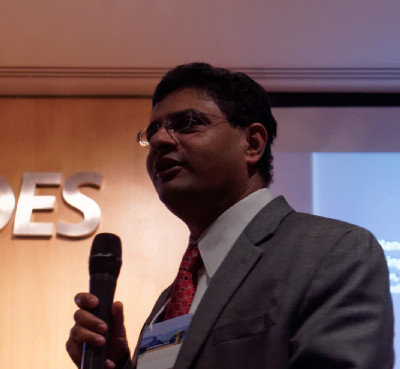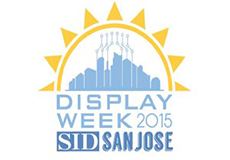The following is a piece written by Sri Peruvemba, CEO of Marketer International and Head of Marketing for the Society for Information Display.
 Sri Peruvemba at Latin Display – photo Meko LtdThe global display industry continues to grow, with new technologies enabling a host of emerging products and applications. To help you keep track of what’s happening and what to keep an eye on in the world of displays, here’s a list of the current top 10 trends in display technology.
Sri Peruvemba at Latin Display – photo Meko LtdThe global display industry continues to grow, with new technologies enabling a host of emerging products and applications. To help you keep track of what’s happening and what to keep an eye on in the world of displays, here’s a list of the current top 10 trends in display technology.
- Wearables
The most high-profile recent entry to the burgeoning wearable market, smart watches will continue to be a hot topic, as more and more companies are beginning to release their own version of this do-it-all timepiece. But wearables comprise more than watches, fitness bands, and, yes, smart glass. Wearable displays for virtual and augmented reality (VR, AR) experiences are on the cusp of being truly ready for broad market availability. All of these applications have to convey large amounts of information on small displays, which must deliver high brightness and resolution with very low power consumption. Thus, organic LED (OLED) and ePaper displays are gaining market share because they’re thinner and lighter, with better color performance; for this category, in particular, flexible OLEDs have a bright future (more on flexible displays below). - Curved Screens
Representing another area of greatly heightened public interest over the past year or so, curved screens have three primary applications:- TVs – With more of the screen directed toward the focal point, where the viewer tends to sit, curved screens create a better and more satisfying viewing experience.
- Smartphones – Curved screens not only make the phone more aesthetically pleasing, but they also create new opportunities for viewing information visible on the curved edge or side of the screen.
- Dashboards – Beautiful curved displays inserted into car dashboards will be highly functional and greatly improve driver usability, eliminating the cluster of jarring right angles that create limitations for previous incarnations of rectangular displays.
- Quantum Dots
According to market research firm IDTechEx, “Quantum dot-enhanced LCD panels are set to capture a 14-percent share of the TV market by 2020.” Quantum dots (QDs) are light-emitting semiconductor nanocrystals that can convert light from one wavelength to other specific wavelengths, creating intense red, green and blue colors. The dots can support large LCDs, making them good candidates for TVscreens and other applications. Backlit QD-LCDs are garnering interest and investment because they greatly improve image quality while costing less than OLED, as the LCD fabs are already in place, many of them fully depreciated. Pioneering companies in this space include Nanosys, which embeds quantum dots into sheets, Quantum Materials, which prints the dots on film, and QD Vision, whose technology routes light from blue LEDs through tubes filled with red and green quantum dots to create pure white light. - More Pixels/Enhanced Readability
Large-screen TVs with UHD/4K technology are starting to hit the market in greater numbers, to cater to buyers’ interest and desire for a range of price points. In addition, there is beginning to be a push for video of the same high quality to be viewable on tablets, wearables and other smaller screens. This will require smaller displays that can accommodate very high-quality content, creating opportunities for companies that can find ways to cram in more pixels per unit of real estate. In the industrial and specialty display markets, there is great interest in 8K pixel resolution. Concurrently, enhanced readability will become an important trend. A number of disparate professions have been using very high-resolution displays for some time, e.g., air traffic control (ATC) and digital x-rays. While both are literally life-or-death applications, their requirements for readability are very different. In the medical space, where the surgeon needs at-a-glance readability of the patient’s information, the display is regularly scanned for pixel defects to ensure all are working perfectly, as many of these displays are monochrome. For ATC, the requirement is large displays with high resolution – the controllers need to be able to see everything easily and study it carefully to make informed decisions. Mainstream applications are now also requiring better displays with higher resolution at both ends of the pixel spectrum, which will benefit these more niche users, as manufacturing efficiencies will deliver even better products at a lower cost. - Better Image Quality
Not everyone thinks more pixels are the only way to enhance the user experience. For example, Pixelworks offers chipsets and algorithms designed to optimize the quality of any display. The technology is predicated on the fact that, due to increased pixel density, the human eye cannot distinguish individual pixels. This means that images are more lifelike than ever and that any artifact can intrude on the viewing experience. Dolby’s HDR (High Dynamic Range) technologies also deliver greater luminosity, along with better contrast and more saturated colors. - Immersive Virtual Reality
Why can’t computing feel completely natural? Magic Leap, a company in the VR field, has posed this question, and rather than taking away from the human experience, immersive VR is meant to be a blend between the digital and real world. Magic Leap’s approach, is a biometric platform for experiencing the digital world that respects how humans naturally function. Oculus (now part of Facebook) is another company that has been working on immersive VR, most famously for its Oculus Rift product that creates a stereoscopic 3D view and has ultra-low-latency 360-degree head tracking – factoring real-life head and eye movement into how users interact with the technology. - Flexible & Foldable/ Rollable Displays
IDTechEx foresees the market for plastic and flexible AMOLED displays will reach $16 billion by 2020. We’ve already begun to see clothing with embedded displays come to market, as technology has been developed to adapt itself to the rigors of fabric wear and maintenance. The eventual goal is to enable users to fold down or roll up virtually any mobile device and put it in a pocket. This creates a huge opportunity, as mentioned earlier, for flexible OLEDs. Samsung and LG Display are creating flexible OLEDs that are literally changing the shape and capabilities of their latest smartphone offerings. Companies like E Ink and Polyera are constructing flexible ePaper displays that are aimed at wearable devices. Glass is still the most popular substrate for displays, but – as noted above – plastic is starting to gain ground. - Secondary Displays
An interesting emerging trend is to have a secondary display on mobile phones. While we tend to focus our attention on a phone’s primary display, there is a great deal of unused real estate on the back of a phone. This space is starting to be utilized for some innovative new always-on secondary displays based on low-power display technologies, which allow the user to access information on the phone’s existing footprint without draining the battery. Some unique solutions currently coming to market include YotaPhone, an Android phone with full-touch capacitive screens on the front (AMOLED) and back, both utilizing Corning Gorilla glass; popSLATE, an iPhone 6 cover that converts the back of the phone into a shatterproof e-paper screen with pushbutton slideshow mode; and the Tegware Bagel, an iPhone 6 case with an integrated e-writer that enables using the included stylus to jot notes or sketches right on the phone. The latter offering also falls into our next trend area – displays for writing. - Displays for Writing
While many of us run our lives using our smartphones, we still tend to turn to pen and paper for taking notes, writing reminders to ourselves, doodling ideas, etc. – it just comes naturally. The next time you are in a meeting, notice how many people brought paper notebooks and pens. Studies have shown that we tend to retain information better when we have used the connection from brain to hand to write it down than when we simply enter, or scan, it into our phones. Displays for writing are thus making a comeback. Many tablets now have a pen input feature, and for smartphones, some new options are being developed, such as the previously mentioned Tegware Bagel. Samsung’s Galaxy Note incorporates pen writing ability and is quite popular. This category also creates new opportunities for plastic displays since plastic tends to win out over glass for e-writing preference. Kent Displays manufactures the Boogie Board line of e-writers, which are available in a variety of sizes and styles. If you’re given to copious note taking, the argument for such a solution is compelling: Kent Displays claims one 8.5 LCD eWriter can save over 50,000 sheets of paper. This would also allow schools to save on resources while still teaching students handwriting (another strong argument in its favor). - Haptic Enabled Displays
Haptic technology is tactile-feedback technology that recreates the sense of touch by applying force, vibration or motion to the user. This feature enhances the keyboard typing experience on a display and creates a more immersive experience in gaming applications, etc. Companies that are already bringing haptic displays to market include Immersion, whose haptic solutions are being used in mobile, gaming, automotive, medical and consumer products, and Novasentis, which is focused on integrating its electro-mechanical polymer (EMP) actuator technology into wearable devices.
As you may have noticed, what’s exciting about many of these trends is not just how they’ll be used, but how they work – it’s the ingredients that make these emerging technologies viable and marketable.
To see demos of many of these fascinating technologies and applications and to hear firsthand from the brightest minds in the display industry how they’re making new display products a reality, plan to attend the 52nd annual Display Week Conference, May 31 – June 5, at the San Jose Convention Center.
We look forward to seeing you at Display Week – where imagination is on display.

